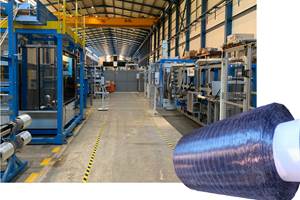The half-full glass
During a recession — and I’ve only known relatively mild downturns until now — an editor always heads off to a trade show with, at best, some hesitancy and, at worst, gloomy pessimism.
During a recession — and I’ve only known relatively mild downturns until now — an editor always heads off to a trade show with, at best, some hesitancy and, at worst, gloomy pessimism. And so it was that I boarded the plane for Paris in March with one eye on the dark economic clouds that chased us out of 2008 and another eye on the JEC Composites show to which I was headed.
I left with mixed emotions: I’ve spent much time over the last seven months, since the world’s financial system began its precipitous disintegration, trying to craft a mindset for dealing with the very challenging economic circumstances in which we find ourselves. I am a naturally optimistic person, so it’s difficult for me to embrace the unrelenting gloominess that confronts us every day — part of me wonders often whether there is some self-fulfillment in prophecies of anticipated struggle and inevitable decline.
On the other hand, this recession is not an abstract notion: Every day, I see physical signs of personal struggle throughout my world. I have friends and family who have lost their jobs and are fighting to keep their homes, much less maintain their standard of living. And we on the HPC staff have endured a round of belt tightening, just like everyone else.
So, I arrived in Paris with my half-full/half-empty glass, unsure of what we’d find at the composites industry’s largest trade event, and full of questions: Would attendance be down, the victim of slashed travel budgets? Would exhibitors offer the old standards rather than premiere new technologies in a market they perceived as unable to invest in innovation? I heard the words “retrench,” “consolidation” and “conserving” a lot from exhibitors whose glasses were half empty and who were looking to get through the next few months while suffering as little damage as possible. Other exhibitors, clearly with glasses half full, talked about a strategy of “chasing market share” during the downturn — seeing revenues contract, but opportunity expand. And the aisles on the show floor, while not bustling like they were in 2008, were at least reassuringly busy.
The rhetoric and down-economy philosophy aside, two things became almost immediately clear as I walked the show and talked with exhibitors and attendees: There is still much work being done in the composites industry and, at least in this industry, creativity and ingenuity don’t take a break when times are tough.
It’s hard, in a recession, not to feel like the entire composites industry has come to a grinding halt, but it’s clear that many of you are rising to the challenge before us, not succumbing to it. I talked at the show to composites professionals who have seen business shrink in marine and automotive but still are pursuing opportunities in healthier wind energy and aerospace sectors. I saw at the show new products and technologies that prove that R&D programs — from out-of-autoclave materials to new pressure vessel manufacturing techniques — are not retrenching or conserving. I met representatives of OEMs who were looking to the composites industry to help them solve weight, strength and corrosion problems in well-known products.
I left Paris with a glass half full and the reassurance that composite materials and structures have a persistent and enduring value. Composites, in fact, are often part of a cure for a variety of engineering challenges, and promise to help guide many of us safely through this downturn. We may have been slowed, but we’ve only been slowed — and I’m already looking forward to getting back to full speed.
Related Content
Hexagon Purus opens new U.S. facility to manufacture composite hydrogen tanks
CW attends the opening of Westminster, Maryland, site and shares the company’s history, vision and leading role in H2 storage systems.
Read MoreHonda begins production of 2025 CR-V e:FCEV with Type 4 hydrogen tanks in U.S.
Model includes new technologies produced at Performance Manufacturing Center (PMC) in Marysville, Ohio, which is part of Honda hydrogen business strategy that includes Class 8 trucks.
Read MoreNovel dry tape for liquid molded composites
MTorres seeks to enable next-gen aircraft and open new markets for composites with low-cost, high-permeability tapes and versatile, high-speed production lines.
Read MoreMingYang reveals 18-MW offshore wind turbine model with 140-meter-long blades
The Chinese wind turbine manufacturer surpasses its 16-MW platform, optimizes wind farm construction costs for 1-GW wind farms.
Read MoreRead Next
The color purple: The "no complaints" movement
So, I finally heard about the “no complaints” movement the other day, which involves wearing a rubberized purple bracelet and switching it from one wrist to the other whenever one utters a negative word.
Read MoreVIDEO: High-volume processing for fiberglass components
Cannon Ergos, a company specializing in high-ton presses and equipment for composites fabrication and plastics processing, displayed automotive and industrial components at CAMX 2024.
Read MoreAll-recycled, needle-punched nonwoven CFRP slashes carbon footprint of Formula 2 seat
Dallara and Tenowo collaborate to produce a race-ready Formula 2 seat using recycled carbon fiber, reducing CO2 emissions by 97.5% compared to virgin materials.
Read More






















